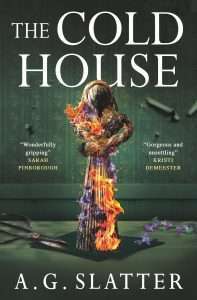Some Ways of Subverting the “Women as a Victim” Trope
My latest novella, The Cold House – published in October for the spookiest of seasons – features Dr Everly Bainbridge, a writer who’s recently been bereaved and is unsure if she wants to go on. When circumstances push her to choose she finds herself as a sort of final girl in someone else’s game – but they don’t know all there is to know about Everly.
 I’m fond of final girls, but not all final girls are created equal. Some are born final and some have finalness thrust upon them, by which I mean some have a survival instinct and will not be messed with, while others take a little while to figure out that no one is coming to save them. Faced with queries (so many queries), I’ve come up with 5 points on the theme (because my brain works best with bullet points), and that theme is roughly how do I construct my heroines to make them not be victims? These techniques are entirely personal to me, other writers will do it differently, so don’t regard this as a proscriptive list.
I’m fond of final girls, but not all final girls are created equal. Some are born final and some have finalness thrust upon them, by which I mean some have a survival instinct and will not be messed with, while others take a little while to figure out that no one is coming to save them. Faced with queries (so many queries), I’ve come up with 5 points on the theme (because my brain works best with bullet points), and that theme is roughly how do I construct my heroines to make them not be victims? These techniques are entirely personal to me, other writers will do it differently, so don’t regard this as a proscriptive list.
Point #1: No gothic fainting goats.
If you’ve seen the reels on Instagram and TikTok of fainting goats you’ll have a visual of what I mean. Something that irks me no end is the old-fashioned screaming, fainting heroine of yore in gothic novels – and it’s not even just of yore, but also in contemporary horror novels (and films). Here’s the thing: not every woman screams or faints when frightened. Yes, yes, I know it’s a particular staple of horror and I do like to call it the “gothic fainting goat effect”.
That’s not to say my heroines don’t spend some time unconscious – Everly certainly does – but I try to keep the occurrences down to a reasonable number, and because they’ve been hit on the head or drugged or are unwell – besides, too many bonks on the noggin will lead to brain damage. They certainly don’t faint because a sudden fit of the vapours has rendered them unable to keep their eyes open.
It also doesn’t mean they’re Terminators who can’t be frightened or stopped either, but if they faint they’re going to be vulnerable. Staying conscious is in their best interests, even if it means seeing something awful; so even the heroines of my gothic novels don’t faint for no reason. And yes, at the end of every novel I do a count of how many times my heroine is rendered unconscious, how and for how long.
So, what’s critical mass for entering gothic fainting goat territory? My randomly chosen number is four periods of unconsciousness – if I’ve hit four, then that’s one too many.
Point #2: Float like a butterfly, sting like a bee.
When I’m writing action/fight scenes I try to keep in mind the character’s physicality because no matter the training or fitness level, a female character isn’t likely (not impossible, of course) to be able to overpower a significantly larger male with the same techniques as a man would use. So, she has to be smarter about how she fights and she’s going to have to be sneaky. Only a fool fights fair when your opponent is well-equipped to kick your arse. Unless the character has supernatural strength and powers – unless she can hulk out – you need the fight and its outcome to be believable in order to keep your reader in the story.
Personally, I also like my heroines to be smart enough to assess the situation they’re getting into, and sometimes that’s going to mean they’ll decide that discretion is the better part of valour and run like hell. Everly does some smart stuff, but also some stupid stuff because she’s angry and loses perspective – and she learns from it.
So: I try to make my protagonists scrappy. They fight dirty, win believably – or bolt for the sake of fighting (and winning) another day.
 Author Angela Slatter Photo by Leah Desborough
Author Angela Slatter Photo by Leah DesboroughPoint #3: Curiosity killed the cat.
One of the big issues I’ve always had with female characters in horror (gothic and modern) is that they’re often punished for their curiosity. Indeed, the whole fairy taley “Be bold, be bold but not too bold” is just another way to make us stop seeking answers to our questions. The idea is that if we know too much, we’ll be in danger, that ignorance will protect us – except we’re already in danger and if we remain ignorant, we won’t be prepared for whatever horror is coming down the pipeline.
So, what I want for my horror heroines is that they live by the motto that knowledge is power. I never want my protagonists to be the sort that bury their heads in the sand and assume everything will be fine, that someone else (a big strong man) will look after them. Everly didn’t do this, but she kind of let her guard down and it bites her in the backside – however, she does start seeking out knowledge very quickly because she knows it’s key to her survival.
One of my favourite lines in anything ever is from Charlotte Bronte’s Villette where Lucy Snow says “self-reliance and exertion were forced upon me by circumstances” and I adore that she recognises this and acts accordingly. Lucy doesn’t have to fight off gothic horrors, but she knows she’s the only person she can rely upon and that knowledge will help her get through life, so she seeks it out, and that’s the attitude I try to infuse into my own final girls.
Point #4: Home, Scary Home.
Everly is in the position where she’s haunted in her own home by memories of her dead husband and daughter, and also by the knowledge that her husband lied about who he was. Her solution is to flee to another home in hope of escaping the familiar environment that keeps reminding her of everything – and things get worse.
Ellen Moers in “Female Gothic: The Monster’s Mother” posits that in gothic stories female characters get to ‘explore’ the domestic sphere the way men get to adventure outside the home. That might sound boring except for the fact that the home (new or old) isn’t always a nice place to be – after all, that’s where the domestic horror occurs. Consequences of bad marriages, dangers of childbearing, the loss of independence (physical, financial, bodily), and also threats that break inside the four walls that are meant to keep you safe, all play out in the home. The domestic sphere – the home, the place where the heart is supposed to be – is what in the best of worlds would be the woman’s safest space, but in horror becomes another locus of danger. And equally heartbreaking whether the story is gothic or contemporary horror, because it’s also often the place where love falls apart or is shown to be false.
Home is also where things hide sometimes in plain sight, where partners take off their masks and show the monsters beneath – the faces they wouldn’t dare display to coworkers, friends or strangers. It’s the place where a woman’s faith in her partner can be absolutely shredded and with it her confidence because she trusted someone who’s been lying all this time. It’s the place where all the excuses they’ve been making for terrible husbands and boyfriends are laid bare. It can be the place where trust dies – so with my heroines, I try to make sure that the home isn’t some saccharine sweet place of safety – I make safety something they have to fight for, the home they want to be safe is somewhere they have to defend – or escape.
Point #5: Sword and shield.
Something that’s critical to me as a horror writer is that my female characters aren’t just thinking of saving themselves – this isn’t always the case, sometimes I write protagonists who are very much all about themselves and their own preservation (note: things don’t end well for them), but for the most part they’re not just out for their own survival. They have a loyalty to and a care for those who can’t defend themselves – think Ripley in Aliens, doing everything she can to rescue Newt, a kid she’s only just met. Is she taking chances? Absolutely! Is she being dumb about it? Nope, she takes calculated risks, is strategic, and doesn’t let her own fear get the best of her. Her fear is her fuel, and she defends the vulnerable. That was one of the things that imprinted on my mind even before I was a writer and it’s stuck with me, that loyalty to the defenceless. I hope readers will always believe that my characters will stay and fight rather than run screaming into the night after they’ve thrown someone else into the jaws of death.
Everly… well, you’ll need to stick around to see what Everly does.
Read The Cold House by A.G. SlatterThis article first appeared in Grimdark Magazine Issue #44
The post Some Ways of Subverting the “Women as a Victim” Trope appeared first on Grimdark Magazine.



